Shadows of rescue workers and volunteers are cast on the wall of an apartment building covered with the spray painted words in Spanish: "Evacuation route" in the southern neighborhood of Tlalpan in Mexico City, Monday, Sept. 25, 2017. The 7.1 magnitude quake on Sept. 19 left the complex's 500 residents, mostly government employees, without a home after one of the 11 buildings collapsed and the others were damaged. (AP Photo/Natacha Pisarenko)
The Associated Press
MEXICO CITY (AP) - Inside the Francisco Kino Elementary School a miniature city has emerged at the site of a shelter for people who lost their homes in last week's deadly earthquake.
On the school's open-air courtyard, doctors test blood pressure and glucose levels at a makeshift triage center set up on a plastic table. Nearby, children get haircuts while stressed-out parents receive massages.
But frustration is growing inside the gym, where families camp out on mattresses alongside piles of new, donated belongings. Days without easy access to a shower and the loss of simple liberties like deciding when to turn out a light to go to asleep have become aggravating.
They want to know: How long will they be stuck here?
"This is like a horror story," said Ana Maria Castaneda, 49, who is living at the shelter with five relatives.
More than 12,000 people whose homes were destroyed or damaged by the magnitude 7.1 quake have spent at least one night in a shelter since the quake, the Mexican government says.
Officials pledged Tuesday to give families chased from their homes a monthly payment of 3,000 pesos - the equivalent of about $170 - to find a new place to live for a total of three months. But an average one-bedroom apartment outside Mexico City's center can easily run twice as much.
"We will directly support families with resources and materials to repair damages or build a new home," President Enrique Pena Nieto said in a televised address Tuesday night.
Government employees fanned out Tuesday urging the 25 families living at the Francisco Kino school to visit a nearby park where officials have set up areas for victims to sign up for benefits, but the suggestion was met with skepticism and resistance. If they went to the plaza, some people worried, they might lose their coveted spots at the shelter. Some 500 families were forced from nearby apartment buildings after one collapsed and the school had space only for two dozen.
"Sorry to interrupt you," one elderly woman sitting on a donated mattress said at a meeting with a visiting representative from Mexico City's Women's Institute. "They tell us if we leave here, we'll lose our shelter. But if we don't go there, we might miss out on government benefits."
"After the fright of the quake, why are they scaring us with these threats?" she asked.
The residents were urged to go one-by-one to sign up for government assistance, leaving family members to watch over their belongings.
According to Mexico City Mayor Miguel Angel Mancera, inspectors have examined damage at 10,903 properties so far and 83 percent of the structures are safe to live in. That means about 1,800 have been marked uninhabitable.
In all, some 43 shelters across the capital have tended to 24,000 people since the Sept. 19 quake, though many came just for a plate of food before finding a place to stay with friends or family.
It's unclear how long the shelters will be operating. Volunteers and government employees stationed at the Francisco Kino school - a shelter run largely by neighborhood residents - said it would stay open for the foreseeable future.
"As long as is necessary," said Elizabeth Garcia, a government worker inspecting the site Tuesday.
The mountain-like piles of donated water bottles and medical supplies along with the growing level of organized services give the impression of a population that is starting to settle in. Rows of toothbrushes and toothpaste rest on sinks outside a children's bathroom. A room that once held school materials has been fashioned into a space for medical donations. A cardboard box holds mounds of antibiotics. On a desk are Styrofoam cups holding injectable medicines like anti-inflammatories that are labeled with a black marker.
Dr. Misael Dominguez, an attending physician, said doctors have "practically everything we require."
"We have seen a lot of high blood pressure and sugar levels from the stress," he added.
At that moment, a doctor was poking one of Roberto Ramirez's fingers with a needle to draw blood and test his glucose levels. Ramirez, a 33-year-old musician and computer programmer, is a diabetic and lives in an apartment that has been deemed too dangerous to inhabit. He was away from home when the quake struck and wasn't able to retrieve his glucose testing kit.
He said he has been trying to take better care of his health since the quake, saying, "I value things more."
The result came back high: 259.
To the left of the entrance are signs offering psychological services. Many of those sheltering at the school have arrived with the quake's trauma still weighing heavily on their minds.
Florencia Cortes, 37, was pulled from the rubble of her apartment building along with her 20-month-old son, Jonatan. In order to get her son out, she had to swing him toward the building's plumber, who happened to be outside. He caught hold of the boy by his foot.
Jonatan used to follow his mother around everywhere. Now she says he stick by his father, who wasn't home during the quake.
"He's not the same," Cortes said. "Maybe he thinks I threw him and don't love him."
Many of the shelter residents harbor a deep mistrust of their government to set things right. While government workers occasionally come in, for the most part officials have been absent, they say. Some are vowing to stay until they're given a new place to call home.
"The government has the last word and no one knows anything about the government here," said Angelina Usuna, 81.
Night can bring the hardest hours. A lucky few have donated mattresses, but most are sleeping on uncomfortable foam mats. They get a few hours of sleep at best. Wary of sharing a collective space, no one feels entitled to tell someone else to be quiet or turn out a light.
In fact, it's impossible to make the gym completely dark. As part of the shelter's safety protocol, one light must be kept on in case another tremor strikes.
A rescue worker walks down a ladder as the search for people continues amid the rubble of a collapsed apartment complex in the southern neighborhood of Tlalpan of Mexico City, Monday Sept. 25, 2017. The 7.1 magnitude quake on Sept. 19 left the complex's 500 residents, mostly government employees, without a home after one of the 11 buildings collapsed and the others were damaged. (AP Photo/Natacha Pisarenko)
The Associated Press
A car sits next to an evacuated apartment building at a large housing complex in the southern neighborhood of Tlalpan, Mexico City, Monday, Sept. 25, 2017. The 7.1 magnitude quake on Sept. 19 left the complex's 500 residents, mostly government employees, without a home after one of the 11 buildings collapsed and the others were damaged. (AP Photo/Natacha Pisarenko)
The Associated Press
Ana Jimena Jaramillo hugs her baby Xarine in their tent at the Francisco Kino school which was turned into a temporary shelter for residents evacuated from the large apartment complex in the Tlalpan neighborhood of Mexico City, Monday, Sept. 25, 2017. The 7.1 magnitude quake on Sept. 19 left the complex's 500 residents, mostly government employees, without a home after one of the 11 buildings collapsed and the others were damaged. (AP Photo/Natacha Pisarenko)
The Associated Press
Caution tape blocks a large apartment complex in the southern neighborhood of Tlalpan in Mexico City, Monday, Sept. 25, 2017. The 7.1 magnitude quake on Sept. 19 left the complex's 500 residents, mostly government employees, without a home after one of the 11 buildings collapsed and the others were damaged. (AP Photo/Natacha Pisarenko)
The Associated Press
Wheelbarrows hold luggage of some of the residents who had to evacuate their apartment complex in the southern neighborhood of Tlalpan in Mexico City, Monday, Sept. 25, 2017. The 7.1 magnitude quake on Sept. 19 left the complex's 500 residents, mostly government employees, without a home after one of the 11 buildings collapsed and the others were damaged. (AP Photo/Natacha Pisarenko)
The Associated Press
Residents displaced by the 7.1 earthquake gather in the patio of the Francisco Kino school, which was turned into a temporary shelter for residents evacuated from a large apartment complex in the Tlalpan neighborhood of Mexico City, Monday, Sept. 25, 2017. The 7.1 magnitude quake on Sept. 19 left the complex's 500 residents, mostly government employees, without a home after one of the 11 buildings collapsed and the others were damaged. (AP Photo/Natacha Pisarenko)
The Associated Press
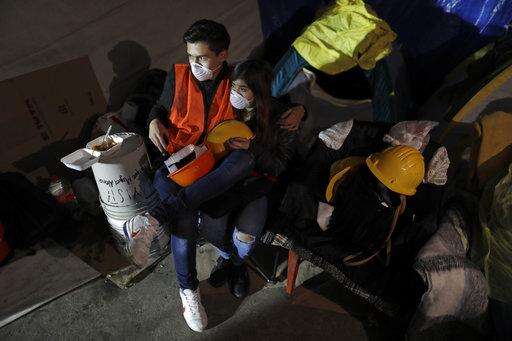
Lender Lopez, who had to evacuate his apartment, and his girlfriend Shaolin Duran prepare to spend the night at the Francisco Kino school, which was turned into a temporary shelter for residents evacuated from the large apartment complex in the Tlalpan neighborhood of Mexico City, Monday, Sept. 25, 2017. The 7.1 magnitude quake on Sept. 19 left the complex's 500 residents, mostly government employees, without a home after one of the 11 buildings collapsed and the others were damaged. (AP Photo/Natacha Pisarenko)
The Associated Press
Volunteers sort donated clothes at the Francisco Kino school, which was turned into a temporary shelter for residents evacuated from the large apartment complex in the Tlalpan neighborhood of Mexico City, Monday, Sept. 25, 2017. The 7.1 magnitude quake on Sept. 19 left the complex's 500 residents, mostly government employees, without a home after one of the 11 buildings collapsed and the others were damaged. (AP Photo/Natacha Pisarenko)
The Associated Press
A girl is checked by a nurse at the Francisco Kino school, which was turned into a temporary shelter for residents evacuated from the large apartment complex in the Tlalpan neighborhood of Mexico City, Monday, Sept. 25, 2017. The 7.1 magnitude quake on Sept. 19 left the complex's 500 residents, mostly government employees, without a home after one of the 11 buildings collapsed and the others were damaged. (AP Photo/Natacha Pisarenko)
The Associated Press

Eduardo Alvarez plays his guitar inside a tent with his pet dogs Lucas and Peluche at the Francisco Kino school, which was turned into a temporary shelter for residents evacuated from the large apartment complex in the Tlalpan neighborhood of Mexico City, Monday, Sept. 25, 2017. The 7.1 magnitude quake on Sept. 19 left the complex's 500 residents, mostly government employees, without a home after one of the 11 buildings collapsed and the others were damaged. Alvarez said he has 11 dogs and decided to keep Lucas and Peluche with him because Peluche would get depressed and Lucas would fight with other dogs. His other dogs are at an animal shelter. (AP Photo/Natacha Pisarenko)
The Associated Press

Volunteers prepare cupcakes adorned with the Spanish phrase: "You are not alone," for displaced residents at the XXX school which was turned into a temporary shelter for residents evacuated from the large apartment complex in the Tlalpan neighborhood of Mexico City, Monday, Sept. 25, 2017. The 7.1 magnitude quake on Sept. 19 left the complex's 500 residents, mostly government employees, without a home after one of the 11 buildings collapsed and the others were damaged. (AP Photo/Natacha Pisarenko)
The Associated Press
Lidia Benhunmea has her hair done at at the Francisco Kino school, which was turned into a temporary shelter for residents evacuated from the large apartment complex in the Tlalpan neighborhood of Mexico City, Monday, Sept. 25, 2017. The 7.1 magnitude quake on Sept. 19 left the complex's 500 residents, mostly government employees, without a home after one of the 11 buildings collapsed and the others were damaged. (AP Photo/Natacha Pisarenko)
The Associated Press
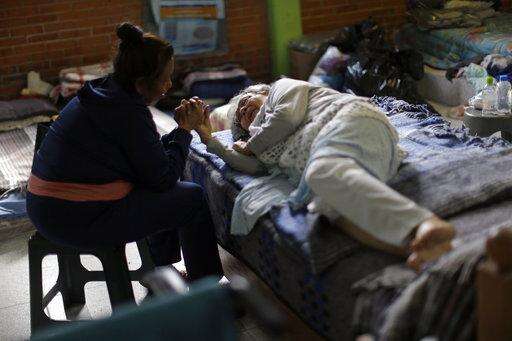
Maria Antonia Lopez holds the hand of 81-year-old Angelina Usuna Garcia at the Francisco Kino school, which was turned into a temporary shelter for residents who had to evacuate their apartment complex where one of the 11 buildings collapsed due to the 7.1 earthquake in the Tlalpan neighborhood of Mexico City, Monday, Sept. 25, 2017. The quake on Sept. 19 left the complex's 500 residents, mostly government employees, without a home. Usuna Garcia said she was at home during the quake. "People have good hearts, because they come and gift us things." (AP Photo/Natacha Pisarenko)
The Associated Press
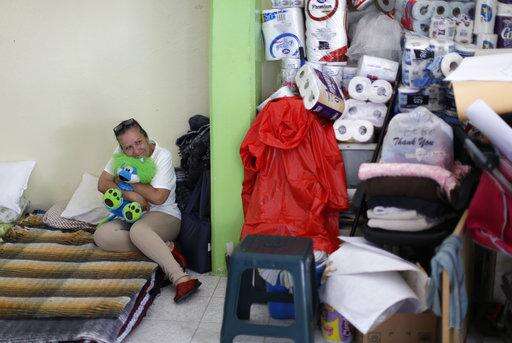
Maria Susana Fernandez hugs a teddy bear on her bed at the Francisco Kino school, which was turned into a temporary shelter for residents evacuated from the large apartment complex in the Tlalpan neighborhood of Mexico City, Monday, Sept. 25, 2017. The 7.1 magnitude quake on Sept. 19 left the complex's 500 residents, mostly government employees, without a home after one of the 11 buildings collapsed and the others were damaged. Fernandez said she and her neighbors don't know if they will be allowed or not to return to their homes, even to recover their items. (AP Photo/Natacha Pisarenko)
The Associated Press
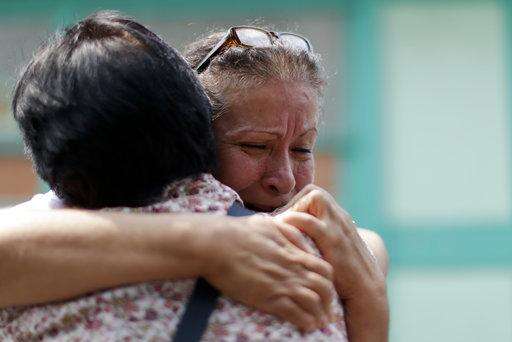
Maria Susana Fernandez Lopez embraces a neighbor outside the Francisco Kino school, which was turned into a temporary shelter for residents evacuated from a large apartment complex in the Tlalpan neighborhood of Mexico City, Monday, Sept. 25, 2017. The 7.1 magnitude quake on Sept. 19 left the complex's 500 residents, mostly government employees, without a home after one of the 11 buildings collapsed and the others were damaged. Fernandez said she and her neighbors don't know if they will be allowed or not to return to their homes, even to recover their items. (AP Photo/Natacha Pisarenko)
The Associated Press

A woman sleeps at the Francisco Kino school, which was turned into a temporary shelter for residents evacuated from the large apartment complex, in the Tlalpan neighborhood of Mexico City, Monday, Sept. 25, 2017. The 7.1 magnitude quake on Sept. 19 left the complex's 500 residents, mostly government employees, without a home after one of the 11 buildings collapsed and the others were damaged. (AP Photo/Natacha Pisarenko)
The Associated Press
Florencia Cortes, 37, cares for her son Jonatan at the Francisco Kino school, which was turned into a temporary shelter for residents evacuated from the large apartment complex in the Tlalpan neighborhood of Mexico City, Monday, Sept. 25, 2017. Cortes was pulled from the rubble of her apartment building along with her 1-year, 8 months-old son, Jonatan. In order to get her son out, she had to swing him toward the buildingâs plumber, who happened to be outside. He caught ahold of the boy by his foot. (AP Photo/Natacha Pisarenko)
The Associated Press

Florencia Cortes, 37, right, sleeps next to her son Jonatan at the Francisco Kino school, which was turned into a temporary shelter for residents evacuated from the large apartment complex in the Tlalpan neighborhood of Mexico City, Monday, Sept. 25, 2017. Cortes was pulled from the rubble of her apartment building along with her 1-year, 8 months-old son, Jonatan. In order to get her son out, she had to swing him toward the buildingâs plumber, who happened to be outside. He caught ahold of the boy by his foot. (AP Photo/Natacha Pisarenko)
The Associated Press
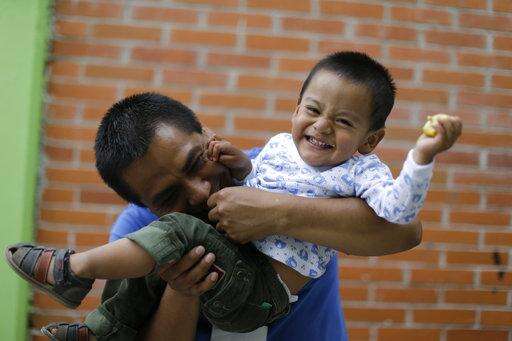
Juan Aldana plays with his son Jonatan while they live inside the Francisco Kino school, which was turned into a temporary shelter for residents evacuated from a large apartment complex in the Tlalpan neighborhood of Mexico City, Monday, Sept. 25, 2017. Aldana's wife Florencia Cortes and Jonatan managed to get out of a building that collapse during Tuesday's Sept 19, earthquake. "He was a miracle from God," Aldana said. (AP Photo/Natacha Pisarenko)
The Associated Press
Marta Garcia gives a massage to a woman living inside the Francisco Kino school, which was turned into a temporary shelter for residents evacuated from a large apartment complex in the Tlalpan neighborhood of Mexico City, Monday, Sept. 25, 2017. The 7.1 magnitude quake on Sept. 19 left the complex's 500 residents, mostly government employees, without a home after one of the 11 buildings collapsed and the others were damaged. (AP Photo/Natacha Pisarenko)
The Associated Press
Carmen Domingues holds her puppy Coco at the Francisco Kino school, which was turned into a temporary shelter for residents evacuated from a large apartment complex in the Tlalpan neighborhood of Mexico City, Monday, Sept. 25, 2017. The 7.1 magnitude quake on Sept. 19 left the complex's 500 residents, mostly government employees, without a home after one of the 11 buildings collapsed and the others were damaged. (AP Photo/Natacha Pisarenko)
The Associated Press
Volunteers organize supplies at the Francisco Kino school, which was turned into a temporary shelter for residents evacuated from the large apartment complex in the Tlalpan neighborhood of Mexico City, Monday, Sept. 25, 2017. The 7.1 magnitude quake on Sept. 19 left the complex's 500 residents, mostly government employees, without a home after one of the 11 buildings collapsed and the others were damaged. (AP Photo/Natacha Pisarenko)
The Associated Press
A rescue worker walks between a collapsed apartment building and another that remained standing at a large apartment complex in the Tlalpan neighborhood of Mexico City, Monday, Sept. 25, 2017. The 7.1 magnitude quake on Sept. 19 left the complex's 500 residents, mostly government employees, without a home after one of the 11 buildings collapsed and the others were damaged. (AP Photo/Natacha Pisarenko)
The Associated Press